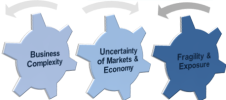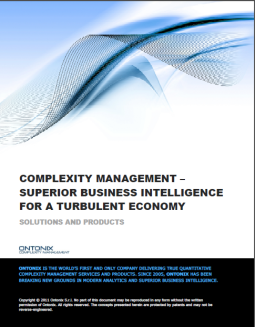Wednesday, 27 October, 2010

The Annual WEF: Global risks report always makes interesting reading but, from a “complexity perspective” this year is of particular interest to us at Ontonix. Of course that is not to say that this is the full extent of the interest! It really gets meaningful when we are able to work with clients to tackle the issues that have been identified.
I have endeavoured to convey in the above graphic the inter-connections between the various domains. As we know, but sometimes forget, more life exists outwith the Economic domain than in it. Hold that thought. Keep it with you. Because interdependence is encoded in what makes and keeps us ALL.
SO, please take the time to read these extracts that, in one way or another, reference risks arising and/or increasing as a result of the “complexity” that comes from inter-connectedness.
The messages are there for corporations to see but, it is very clear that, unless the carriers of financial and insurance risk proactively tackle the task of providing solutions they will fail their global clients, shareholders, reinsurers, investors, etc.
Attempting to resolve 21st century risks with 20th century tools and techniques can only have one outcome.
Cross-cutting themes
Three themes provide the backdrop for discussion in this report. As the first chapter discusses, the increase in interconnections among risks means a higher level of systemic risk than ever before. Thus, there is a greater need for an integrated and more systemic approach to risk management and response by the public and private sectors alike. Second, while sudden shocks can have a huge impact, be they serious geopolitical incidents, terrorist attacks or natural catastrophes, the biggest risks facing the world today may be from slow failures or creeping risks. Because these failures and risks emerge over a long period of time, their potentially enormous impact and long-term implications can be vastly underestimated.
The Global Risks 5i Framework applied to transnational crime and corruption
Insight: Crime and corruption thrive on the increasing complexity and opacity of supply chains and global markets. While various actors and institutions have visibility into segments of the chain, most often they lack the complete overview of the chain and interactions within it. Forward-looking risk management must therefore identify these interlinkages and account for the entire sequence of exchanges from the source to the distribution to end customers, identifying the trading routes and facilitators connecting each step.
Critical Information Systems and Cyber vulnerability Read more of this post


 I “had” to share Part 1 of this blog earlier, under the title “
I “had” to share Part 1 of this blog earlier, under the title “
 My esteemed colleague, Bala Desphande (at Ontonix USA), delivers…as usual! If you want to read the full article here is the link:
My esteemed colleague, Bala Desphande (at Ontonix USA), delivers…as usual! If you want to read the full article here is the link: 









